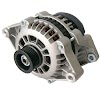Wind power plant
The wind, one of nature’s most abundant resources, is a form of
solar energy. It is renewable, nonpolluting, universally available, and free of
cost. In short, wind is a stream of moving air molecules circulated by the suns
unequal heating of the earth’s surface. The power in the wind is the sum of all
the moving molecules of air, and according to the law of fluid dynamics, is proportional
to the speed of the wind. The amount of air in constant circulation around the
earth is estimated to 5 quadrillion tones. If we could extract 10% of the
global energy potential of the wind, we would comfortably meet the world’s
energy requirements from that source alone.
Construction and working of wind
power plant:
Winds turbines capture the kinetic energy in surface winds are convert it into electrical energy in the form of electricity-producing rotors. To do this use they use three basic parts: blades, a shaft and a generator. As wind moves over turbine blades, it causes “lift” – the same effect used by airplane wings. Lift makes the blades rotate. The turning blades turn a shaft. The turning shaft moves a magnetic field in the generator, which in turn creates electricity and is as shown bellow fig
wind power plant:
A wind turbine works the opposite of a fan. Instead of using
electricity to make wind, like a fan, wind turbines use wind to make
electricity. The wind turns the blades, which spin a shaft, which connects to a
generator and makes electricity.
Wind turbines commonly being to produce power at a wind speed
of 7-30m/sec. wind plants produce electricity only when the wind blows, so if
the wind is not blowing, the plant is not producing electricity. For this
reason, wind is called an intermittent
resource.
Advantages of wind
power
Wind energy offers many advantages. Research efforts are aimed at addressing the challenges to greater use of wind energy. Wind energy is an ideal renewable energy because:
1 It is a pollution-free, infinitely sustainable from of energy
2. It doesn’t require fuel
3. It doesn’t create greenhouse gasses
4. It doesn’t produce co2 or toxic or radioactive waste.
5. Wind energy is quiet and does not present any signification hazard to birds or birds or other wildlife.
6. Infinite energy source
7. The land beneath can usually still be used for faming
8. Wind farms can be tourist attractions.
9. A good method of supplying energy to remote areas
Disadvantages of wind power plant
1. Wind power technology requires a higher investment that fossil-fueled generators.
2. Wind is intermittent and it does not always blow when electricity is needed.
3. Suitable areas for wind farms are often near the coast, where land is expensive
4. Good wind sites are often located in remote locations, far from cities where the electricity is needed.
5. Can affect television reception if you live nearly
6. Wind resource development may compete with other uses for the rotor blades, aesthetic (visual) impacts, and sometimes birds have been killed by flying into the rotor
7. Is liable to be affected by natural conditions such as the weather and has large output variations
8. The noise creates by the windmills as well as their influence on the landscape may become problematic.










0 Comments